Alice Wandesford Thornton (1626-1707): Anniversary Special
Thursday 1st February 2024 marks the 317th anniversary of the burial of Alice Thornton, followed - on 13 February – by the 398th anniversary of her birth. To mark these occasions, this month’s post will be looking back at Alice’s life through items held at a variety of archives and libraries in England and Ireland.
We will start with the earliest document we have found related to Alice Wandesford Thornton and then a document from each decade of her life ending with one of the last documents we have written by Thornton.
Baptised in 1626
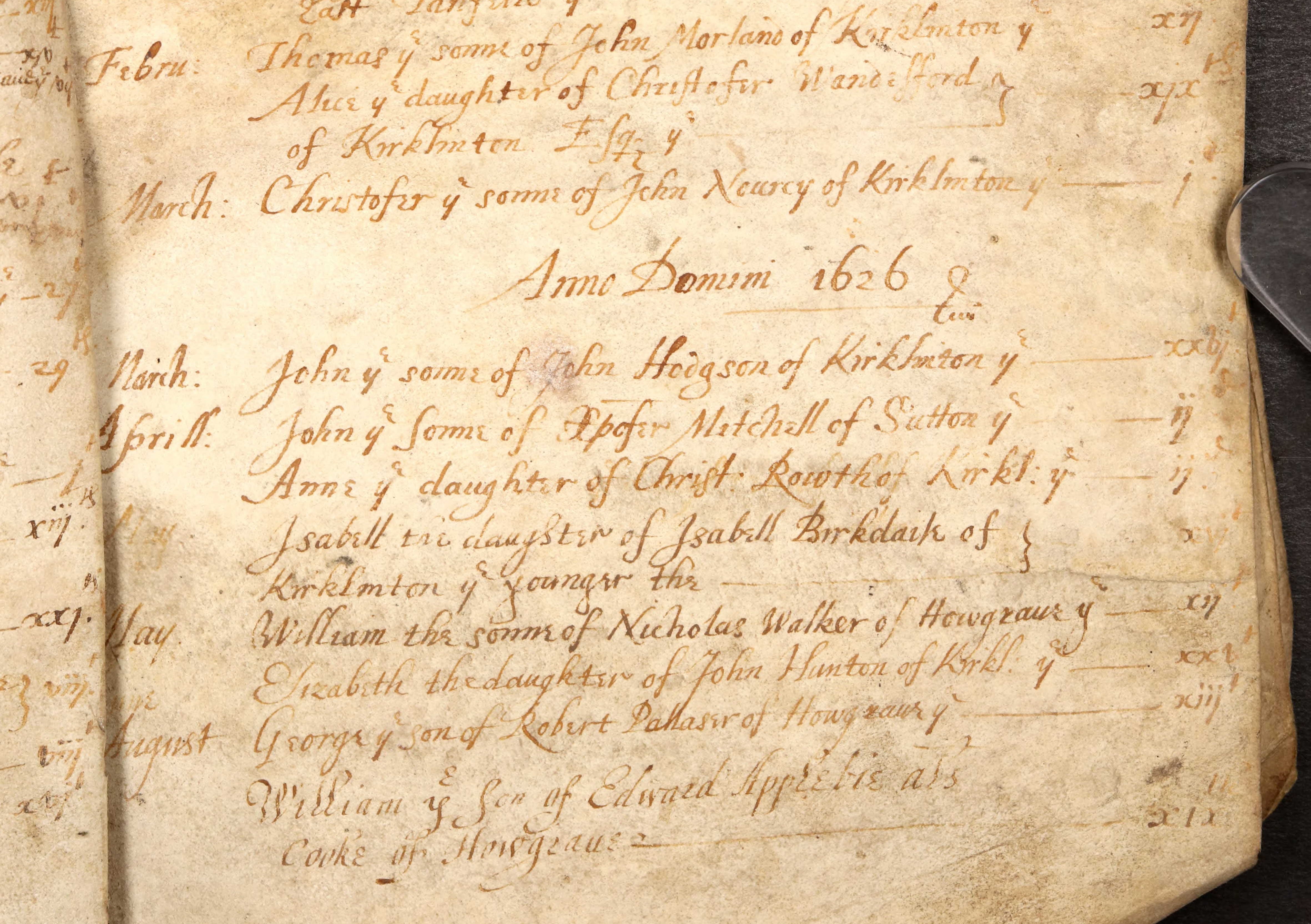
Alice was born on 13 February 1626. The parish registers of St Michael, Kirklington, held at North Yorkshire County Record Office (NYCRO), record her baptism – ‘Alice the daughter of Christopher Wandesford of Kirklington’ - as 19 February, six days later.[1]
Receiving a Letter from Dublin, 1639
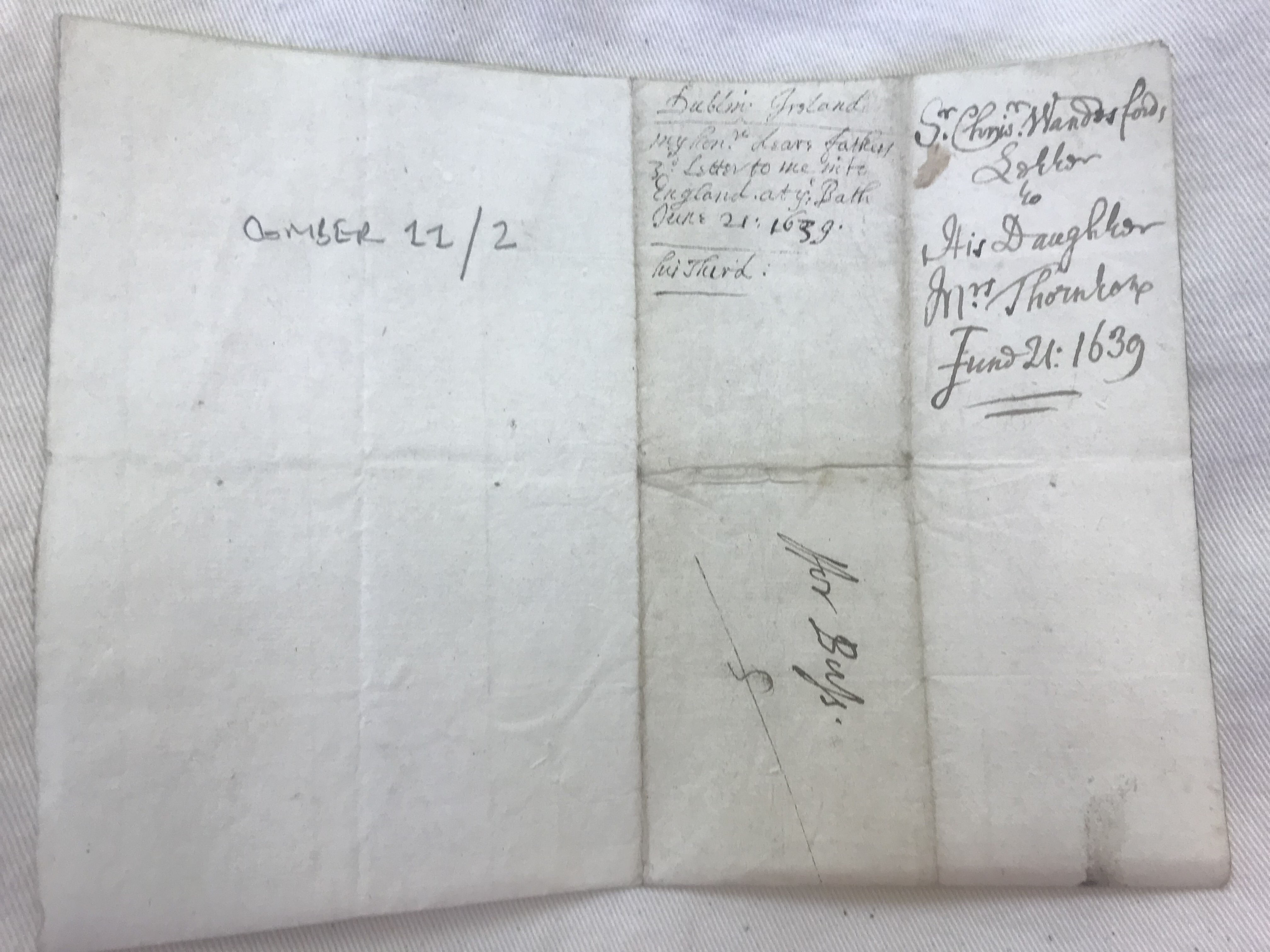
In c.1634 Alice moved to Dublin as her father, Christopher Wandesford, had taken up a government role in Ireland. In 1639 she spent a few months in England while her mother tried out various water cures in Bristol and Bath. During this time, Alice’s father sent her a number of letters. The third of these is kept by Durham Cathedral Library. The letter from her father is labelled by Thornton, ‘My honoured dear father’s 3rd letter to me into England at the Bath’. In the letter, her father twice addressed her by the nickname ‘Buss’.
Copying her Father’s Will, 1647
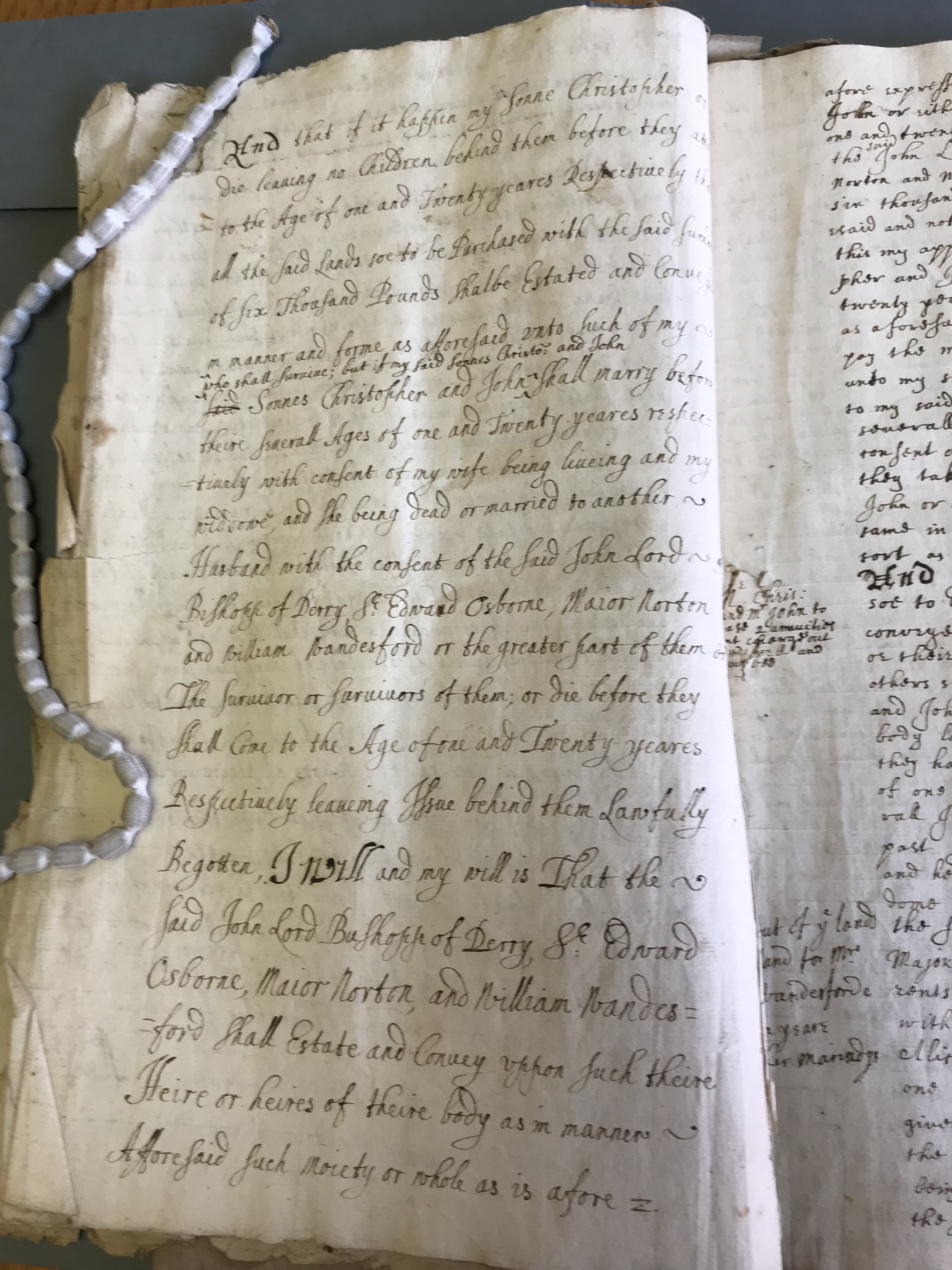
Alice’s father died on 3 December 1640. He had made a last will and testament on 2 October 1640 which provided for his family, but the will was lost in the upheaval following the Irish Rebellion of 1641. This caused the family many problems. In this will, Christopher Wandesford left his daughter £1,500 from his Kirklington estate in Yorkshire, to be paid at age 21 (or on marriage), plus yearly maintenance until that point, and £1,000 from his Irish estate to be paid a year after any marriage.
Thornton recounts in Book 2: The First Book of My Widowed Condition that her older brother, George, went to Ireland in 1647 to get a copy of the will. He saw the original and brought back a copy and he, his brothers and Alice all copied it out,[2] as can be seen by the multiple hands in the surviving copy, now held by the National Library of Ireland in Dublin.
Giving Evidence to Chancery, 1656
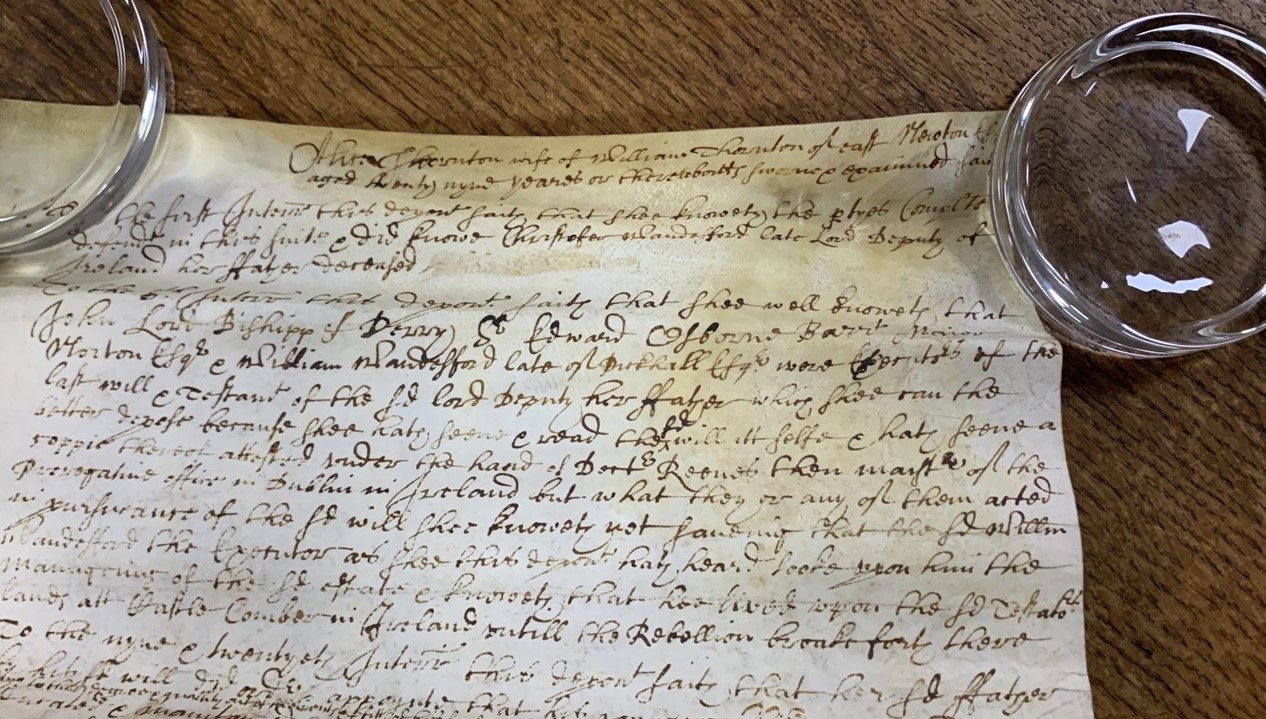
The will was still not on file, though, and Alice and family were still arguing about the will’s contents throughout the 1650s. In 1656 Alice, alongside her husband, William Thornton, and her mother, Alice Wandesford, gave evidence to Chancery about the contents of the will in a case brought by one Robert Nettleton against William Wandesford, who was Wandesford’s executor, about non-payment of a debt. Thornton, aged 30, stated that she was ‘aged twenty-nine or thereabouts’ in the surviving deposition at the National Archives, Kew.[3]
Securing a Deed of Settlement for her Children, 1667
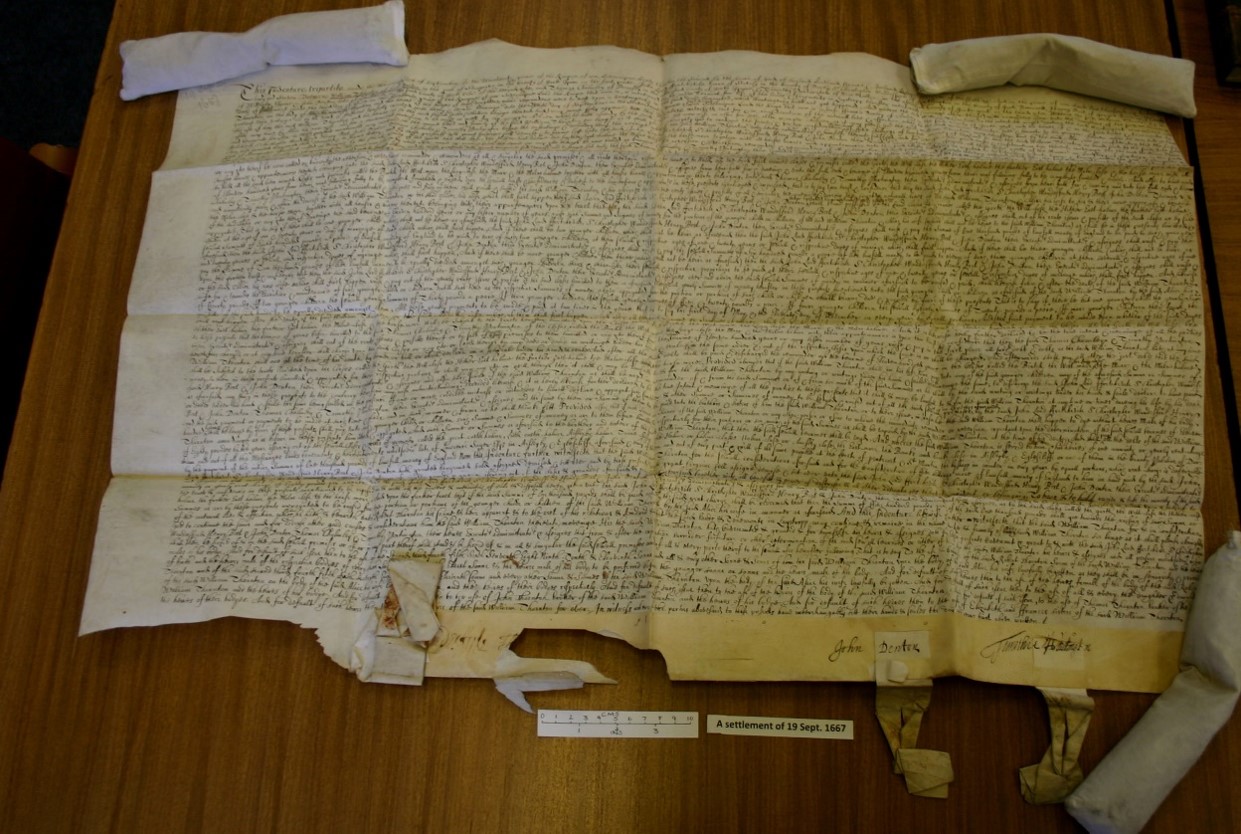
In the 1660s Alice Thornton’s attention turned towards making sure her children would be provided for in the event of her or her husband’s death. A settlement had been agreed when they married in 1651 but Alice had agreed to the sale of some of the land intended for her younger children c.1656 to cover some of William’s debts. In the 1660s when she was still trying to give William a male heir, she found out that the marriage settlement allowed him to disinherit her children in favour of any from a subsequent marriage. Book 2 is very detailed on her attempts to get this amended from 1660-7. Indeed, the book ends with the words ‘This last Deed of Leysthorpe was dated September 19th 1667.’[4]
This deed of 1667 has survived and is now at Durham Cathedral Library, gifted in 2019. It is an agreement between William Thornton and six kinsmen, divided into two groups, who had already been leased some of the Leysthorpe lands by William. The deed references previous deeds of 1662 and 1665, also discussed in Book 2. With the 1667 document, he sought – at Alice’s behest – to secure provision for his daughters, Alice and Katherine, from these lands. The girls were both to receive £800 from the rents and profits of Leysthorpe when they reached 21 or married and, if one of their parents died, they were to receive money for their maintenance and education. The parties had added their seals; these are now missing but there are some surviving seal tags to which the seals would have been attached.
Writing to her Brother, 1677
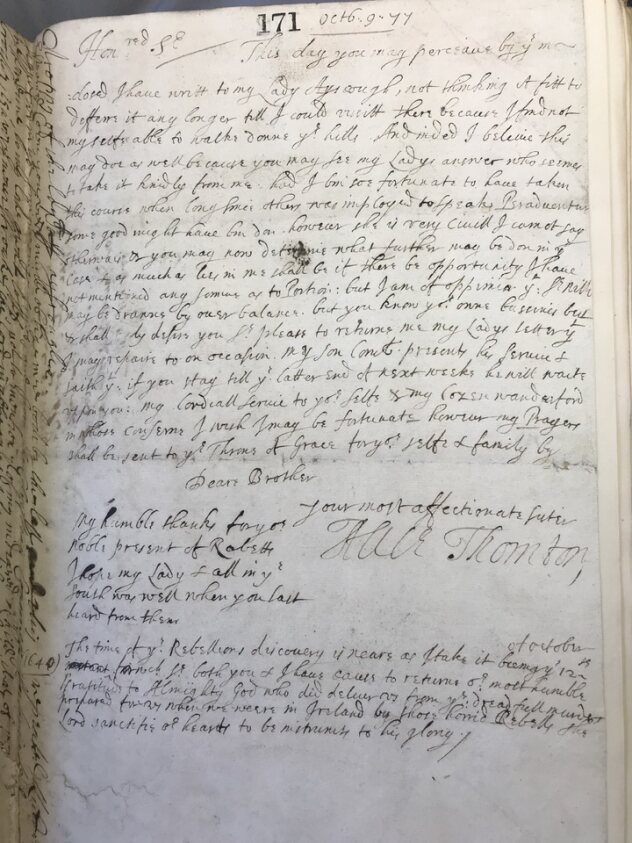
Thornton was widowed in 1668. A couple of letters that she wrote to her brother, Christopher Wandesford, have survived at the National Library of Ireland as part of the Ormonde papers. In one, dated 9 October 1677, she tells Christopher that she had written to Lady Ayscough to help negotiate a marriage between one of his daughters and the Ayscoughs’ son. In this letter Thornton refers to her poor health as the reason for not making the trip to Osgodby Hall, Thirkleby to visit Lady Ayscough in person: ‘I find not myself able to walk down the hills’. In Lady Ayscough’s reply, copied onto the letter, she references ‘the high hills betwixt us’ and Thornton’s ‘weaknesses, which I am glad to learn is moved’. These hills, the Hambleton Hills, are referenced in Book 1: The First Book of My Life as causing Thornton difficulties in early 1652 when she was pregnant for the first time.[5]
Writing to her Cousin, Lord Danby, 1689
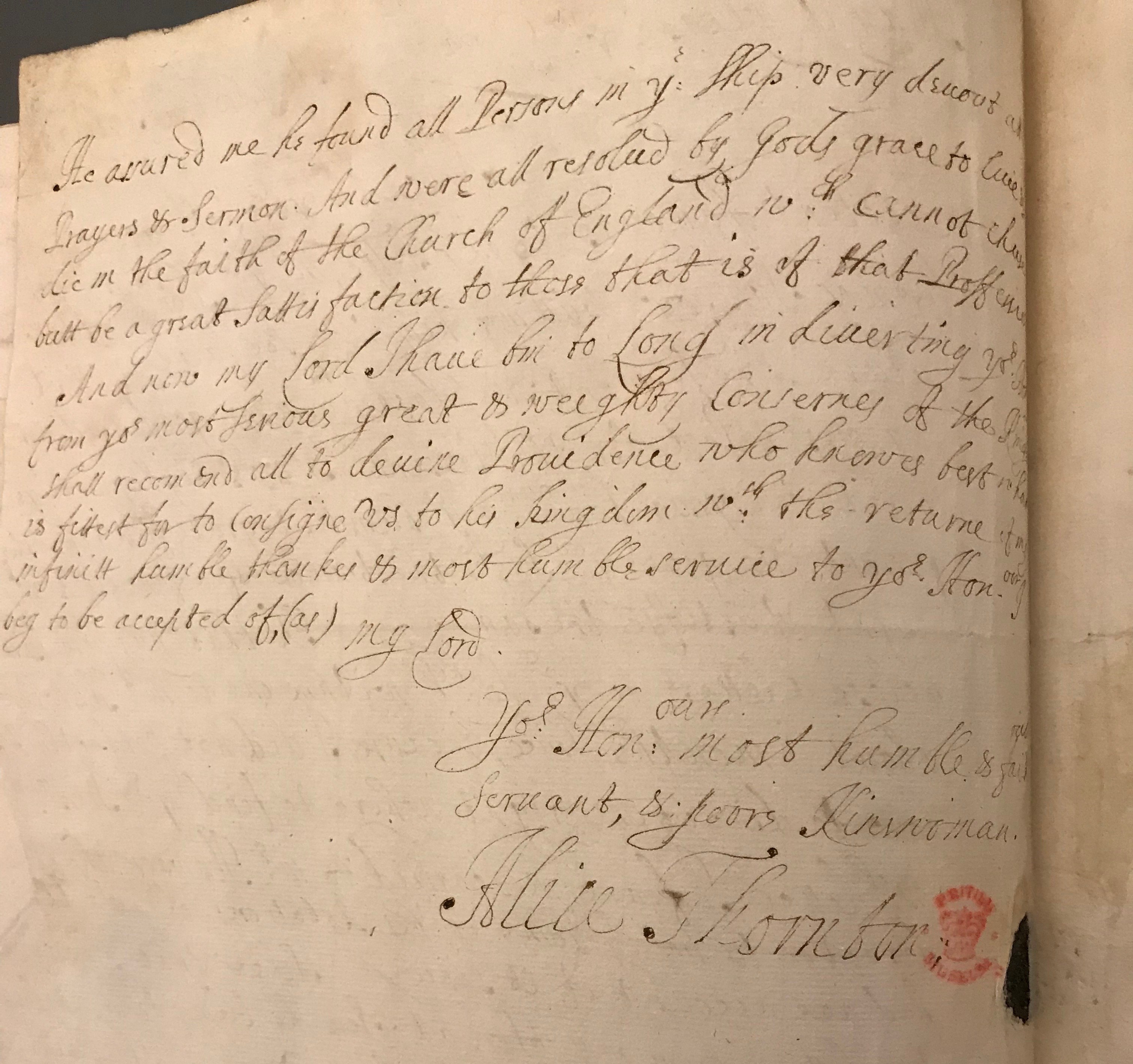
A decade on, in July 1689 we find Alice Thornton writing to her cousin, Lord Danby, who was then President of the royal Council, under William and Mary. She was thanking him for helping her only son, Robert, find a position on a naval ship which was heading to Spain: ‘He assured me he found all persons in the ship very devout at prayers and sermon’. In 1688 Robert was being pursued for his debts which might explain why Alice was happy for Lord Danby’s help ‘putting him … so far away’. This letter is held by the British Library.
According to Book Three: The Second Book of My Widowed Consition, she also wrote to Lord Danby, who now had the title of Marquess of Carmarthen, in September 1689. This time she was seeking his help advancing her son-in-law, Thomas Comber, in the church.[6] Comber worked on this connection too, making Danby a godfather to one of his children, and his patronage was partly responsible for Comber being made Dean of York in 1691.[7]
Writing Her Second Widowed Book, c.1692-6
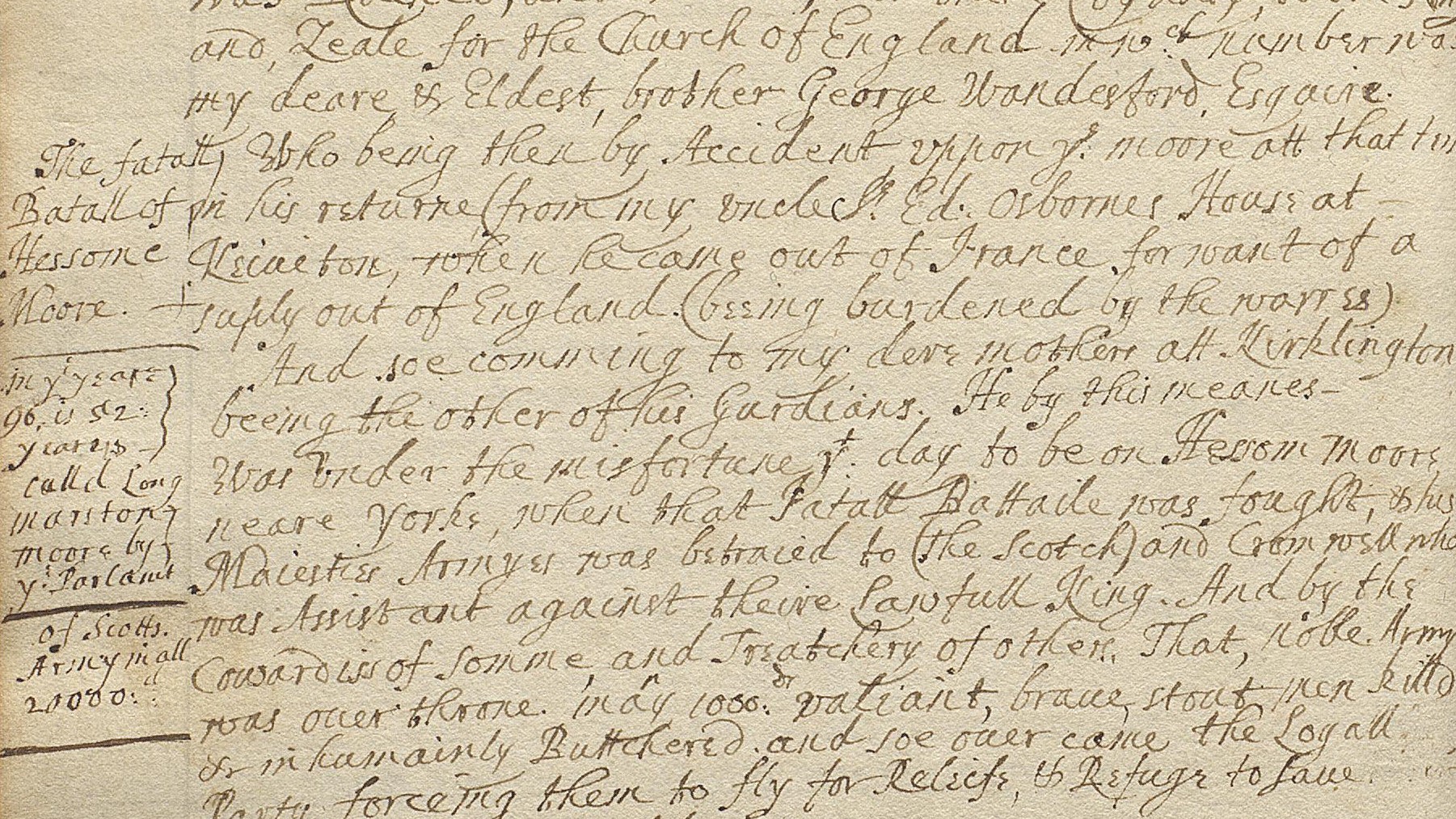
We believe that Thornton’s Book 3 was written in the 1690s. Besides the reference to the letter sent to Lord Danby in 1689, Thornton also refers to ‘my dear son Thornton’s decease without issue’.[8] Robert Thornton, her only son that lived to adulthood, died in June 1692, aged 29. There is also a marginal comment that was added in 1696, noting it had been 52 years since the Battle of Marston Moor (1644).[9] In 1696, Thornton would have been seventy years old.
Making Her Last Will and Testament, 1705
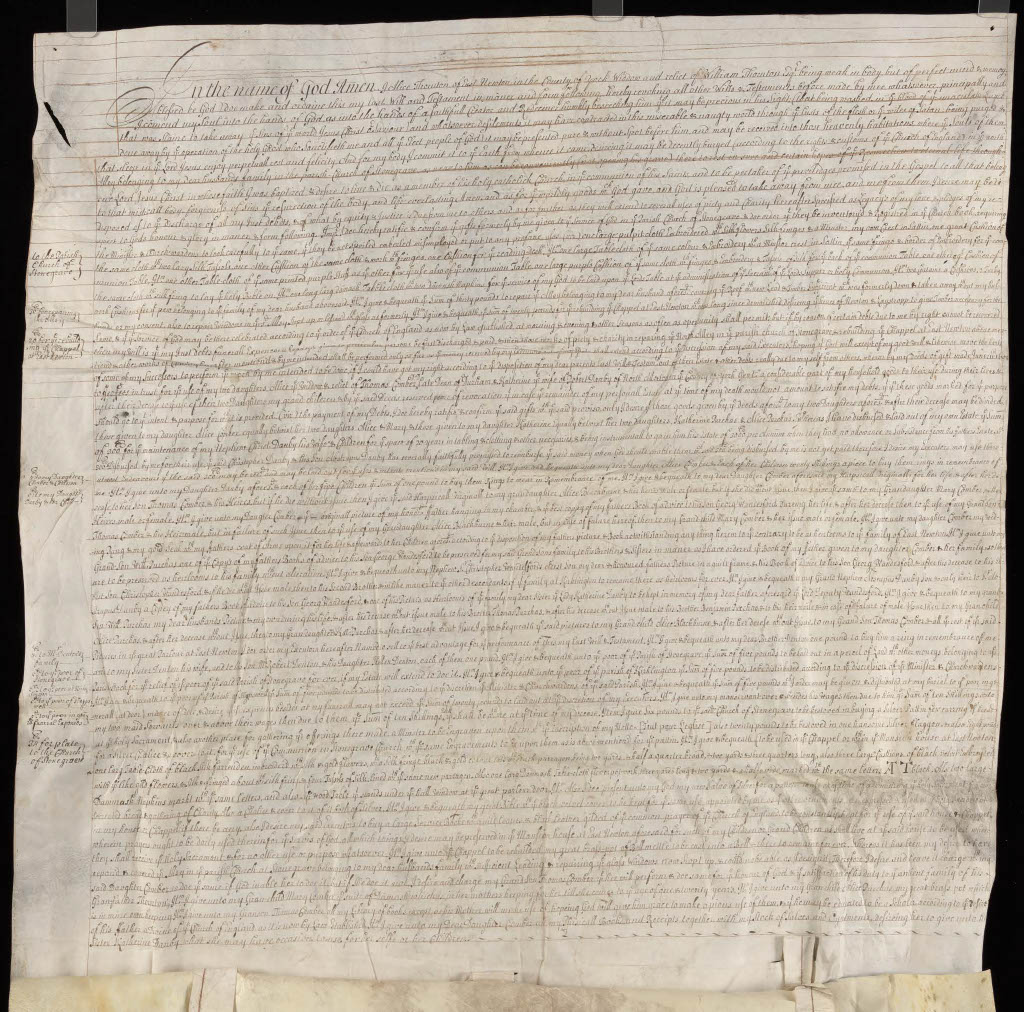
Thornton died in January 1707 and was buried on 1 February at Stonegrave in Ryedale, as recorded in the parish register where she is referred to as ‘Madam Thornton’.[10] There is a letter from Thornton to her great-nephew, Abstrupus Nephew, dated 26 March 1705, which is the latest piece of writing in her hand that we have found.[11] But, for a very full text from her final years, we will turn to her last will and testament, made 10 April 1705 and proved 15 April 1707, with both an original and registered copy surviving at the Borthwick Institute for Archives, York.[12]
This document opens with a reference to her being ‘weak in body’. The will initially concerns all the items she had previously given to her parish church, Stonegrave, and what she intended to give on her decease. It then notes that Thornton had already, in 1684, put most of her goods in trust for her daughters, Alice and Katherine, who were both married, as her mother had done for her. These goods were then to be passed to her four granddaughters. The will also notes, as Thornton did many times in her books, that she had provided for her nephew, Christopher Danby, and his family for twenty years at a cost of £300. She therefore instructed her executors to pursue that money from her great-nephew, Abstrupus Danby, then resident at Swinton Park.
Her children and grandchildren were left rings ‘to wear in remembrance of me’. Her oldest daughter, Alice Comber, was to get her wedding ring and wedding bodice, some Wandesford heirlooms, as well as ‘three books of my own meditations and transactions of my life’, and all other papers and books written in her own hand, including her ‘physic books and recipes’. The books of her life clearly became family heirlooms too and stayed in Comber family hands for centuries.
This post was inspired by the West Yorkshire Archive Service Blog post on Anne Lister in 2022. We hope you have enjoyed this run through Alice Thornton's life and its documentary traces.
Modernised from 'Kirklington baptism, marriage and burial register, 1568-1680', PR/KRT 1/1, North Yorkshire County Record Office. ‘Alice the daughter of Christofer Wandesford of Kirklinton Esqr’. ↩︎
Alice Thornton, Book 2: The First Book of My Widowed Condition (hereafter Book 2), Durham Cathedral Library, GB-0033-CCOM 7, 36-53. ↩︎
In Book 2, she dates this to 3 November 1658, so ether it was a long-running case or she was mistaken. Book 2, 37, 61. ↩︎
The text quoted above is from our work-in-progress edition of Alice Thornton's Books. The text is modernised in the body of the blog and the semi-diplomatic transcription is reproduced here in the notes. 'This last Deed of Laistrop was dated Sept. 19th 1667.' Book 2, page 293. ↩︎
Alice Thornton, Book 1: The First Book of My Life, British Library MS Add 88897/1, 127. ↩︎
Alice Thornton, Book 3: The Second Book of My Widowed Condition (hereafter Book 3), British Library MS Add 88897/2, 189. ↩︎
Andrew M. Coleby, "Comber, Thomas (1645–1699), dean of Durham and liturgist." Oxford Dictionary of National Biography. 23 Sep. 2004; Accessed 30 Jan. 2024. ↩︎
Book 3, 152. ↩︎
Book 3, 31. ↩︎
'Stonegrave baptism, marriage and burial register, 1584-1750', PR/STV 1/1, North Yorkshire County Record Office. ↩︎
Alice Thornton, 'Letter to Abstrupus Danby, 26 March 1705'. North Yorkshire County Record Office, ZS - Swinton and Middleham Estate Records, MIC 1274/6729. ↩︎
York Diocesan Archive, Alice Thornton of East Newton, May 1707, Rydall Exchequer Court, Borthwick Institute for Archives, University of York; Probate Register of the court of the Archbishop of York for the years 1707-1708, Vol. 64, 45. ↩︎
Citing this web page:
Cordelia Beattie. 'Alice Wandesford Thornton (1626-1707): Anniversary Special'. Alice Thornton's Books. Accessed .https://thornton.kdl.kcl.ac.uk/posts/blog/2024-02-01-AnniversaryBlog/